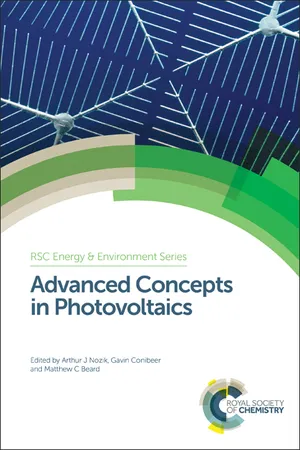
Advanced Concepts in Photovoltaics
- 608 pages
- English
- PDF
- Available on iOS & Android
Advanced Concepts in Photovoltaics
About This Book
Photovoltaic systems enable the sun's energy to be converted directly into electricity using semiconductor solar cells. The ultimate goal of photovoltaic research and development is to reduce the cost of solar power to reach or even become lower than the cost of electricity generated from fossil and nuclear fuels. The power conversion efficiency and the cost per unit area of the phototvoltaic system are critical factors that determine the cost of photovoltaic electricity. Until recently, the power conversion efficiency of single-junction photovoltaic cells has been limited to approximately 33% - the so-called Shockley-Queisser limit.
This book presents the latest developments in photovoltaics which seek to either reach or surpass the Shockley-Queisser limit, and to lower the cell cost per unit area. Progress toward this ultimate goal is presented for the three generations of photovoltaic cells: the 1st generation based on crystalline silicon semiconductors; the 2nd generation based on thin film silicon, compound semiconductors, amorphous silicon, and various mesoscopic structures; and the 3rd generation based on the unique properties of nanoscale materials, new inorganic and organic photoconversion materials, highly efficientmulti-junction cells with low cost solar concentration, and novel photovoltaic processes.
The extent to which photovoltaic materials and processes can meet the expectations of efficient and cost effective solar energy conversion to electricity is discussed. Written by an international team of expert contributors, and with researchers in academia, national research laboratories, and industry in mind, this book is a comprehensive guide to recent progress in photovoltaics and essential for any library or laboratory in the field.
Frequently asked questions
Information
Table of contents
- Advanced Concepts in Photovoltaics
- Contents
- Chapter 1 Crystalline Silicon Solar Cells with High Efficiency
- Chapter 2 Tandem and Multiple-junction Devices Based on Thin-film Silicon Technology
- Chapter 3 Thin-film CdTe Photovoltaic Solar Cell Devices
- Chapter 4 III–V Multi-junction Solar Cells
- Chapter 5 Thin-film Photovoltaics Based on Earth-abundant Materials
- Chapter 6 Chemistry of Sensitizers for Dye-sensitized Solar Cells
- Chapter 7 Perovskite Solar Cells
- Chapter 8 All-oxide Photovoltaics
- Chapter 9 Active Layer Limitations and Non-geminate Recombination in Polymer–Fullerene Bulk Heterojunction Solar Cells
- Chapter 10 Singlet Fission and 1,3-Diphenylisobenzofuran as a Model Chromophore
- Chapter 11 Quantum Confined Semiconductors for Enhancing Solar Photoconversion through Multiple Exciton Generation
- Chapter 12 Hot Carrier Solar Cells
- Chapter 13 Intermediate Band Solar Cells
- Chapter 14 Spectral Conversion for Thin Film Solar Cells and Luminescent Solar Concentrators
- Chapter 15 Triplet–triplet Annihilation Up-conversion
- Chapter 16 Quantum Rectennas for Photovoltaics
- Chapter 17 Real World Effciency Limits: the Shockley–Queisser Model as a Starting Point
- Chapter 18 Grid Parity and its Implications for Energy Policy and Regulation
- Subject Index